Shit Here We Go Again Green Screen

From bringing Jurassic World's all-too-existent raptors back from extinction to rendering Blackness Panther'southward Wakanda in boundless particular, the use of light-green screens in the field of visual effects (VFX) helps create unbelievably "real" pic magic.
Using this special technique, ii distinct images or video streams can be layered (or, as the pros say, composited) together, allowing filmmakers to put annihilation they can dream upwards on screen. Take a peek behind the scenes of your favorite Hollywood blockbusters to encounter what iconic moments wait like before the VFX squad works their magic. Spoiler: It's ridiculous!
Tiger and Scenery from Life of Pi
Directed by visionary filmmaker Ang Lee, 2012'southward Life of Pi earned more than $609 million worldwide and clinched 4 of its xi Oscar nominations. In the moving-picture show, a young Indian homo named "Pi" Patel tells a novelist his life story.

At age xvi, he survived a shipwreck and, adrift in the Pacific Ocean, shared a lifeboat with a Bengal tiger — a.one thousand.a. a lumpy, blue screen-coated stuffed animal. "Every shot was artistic exploration," said VFX Supervisor Bill Westenhofer. "To make the body of water a graphic symbol and make it interesting, we had to strive to make it as visually stunning equally possible."
The fast-talking, (arguably) saltiest member of the Guardians of the Galaxy is Rocket Raccoon. Smart and easily annoyed, he is voiced by Bradley Cooper, just all of his lines are recorded in a studio — far away from maquettes and green screens.
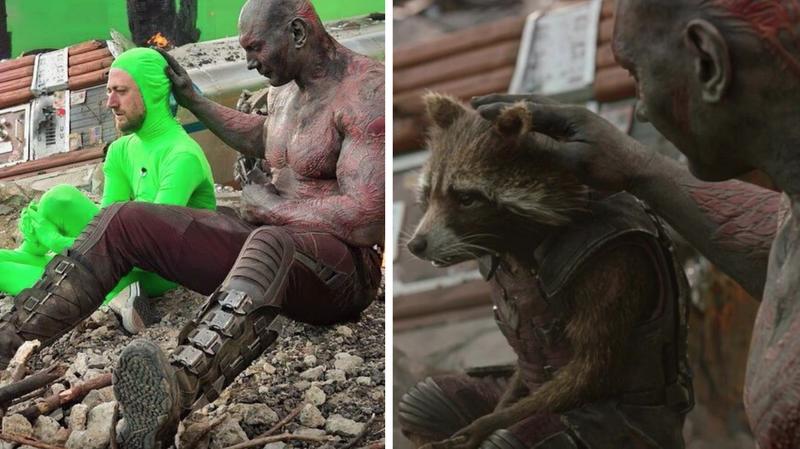
Much like wolf-Jacob from the Twilight Saga, Rocket has a human stand up-in instead of an inanimate prop. This means the other actors have someone to interact with, and equally a bonus, VFX artists can employ the motion capture performers facial expressions and (sometimes) gestures if needed. In this scene, though, most of the mo-cap performer was completely removed from the film, cheers to that wearable light-green screen.
About Everything in Gravity
This 2013 space thriller was directed by Alfonso Cuarón and starred Oscar winners Sandra Bullock and George Clooney as astronauts who get stranded in space after their infinite shuttle is destroyed. Unsurprisingly, the seven-fourth dimension University Award-winning film cleaned upwards when it came to special effects.
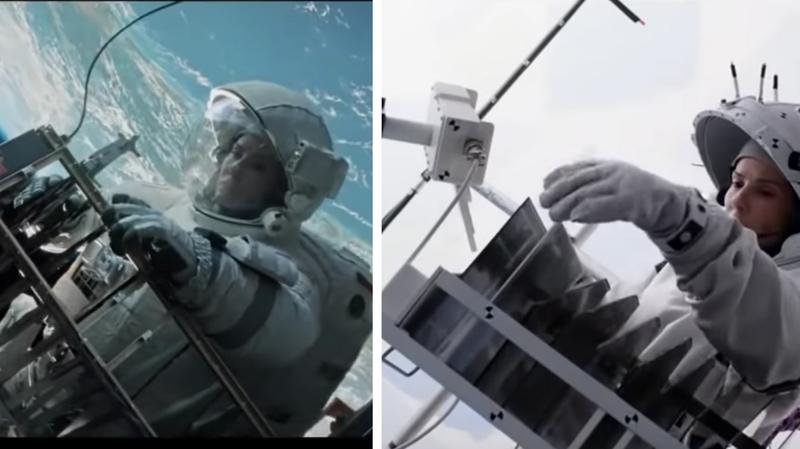
As viewers watch Bullock struggle to return to Globe, they forget that most of what they're looking at is figurer-generated. According to VFX supervisor Tim Webber, a staggering lxxx% of Gravity consists of CGI. Moreover, to simulate the manner unfiltered light in space reflects off objects, the furnishings team manually controlled a lighting system made of one.8 million LED lights.
Dinosaurs in Jurassic Earth — Before
Sci-fi take a chance film Jurassic World (2015) is the 4th pic in the Jurassic Park serial, which debuted fashion dorsum in 1993. Set 22 years after the classic Steven Spielberg film, Jurassic World holds to a similar premise: A theme park full of cloned dinosaurs is plunged into utter anarchy when a dangerous dino escapes from its enclosure.

Although the picture cost a whopping $150 million to make, all those VFX dinosaurs paid off — literally. Jurassic World generated $1.6 billion in box office acquirement, making it one of the highest-grossing films of all time.
Dinosaurs in Jurassic World — After
In the original moving picture, the VFX were done by George Lucas' Industrial Low-cal & Magic — the technical wizards responsible for the amazing visuals in the Star Wars films. A new technology was introduced for Jurassic Park — Dinosaur Input Devices, which were models that fed information into computers, allowing them to animate the creatures like end motion puppets.

Like with the original films, Jurassic Earth relied on a mixture of animatronic dinosaurs and computer-generated ones. One added benefit? Move capture technology. In this scene, Chris Pratt's character wards off some raptors, which were "played" by actors in suits and shot confronting a green screen.
Heroics in Spider-Human being: Homecoming
Fifty-fifty your friendly, neighborhood Spider-Man needs a helping mitt at times. For Spider-Man: Homecoming, the VFX teams wanted to accomplish new heights and fifty-fifty studied translucent polar comport hair to give Spidey's webs a realistic look.
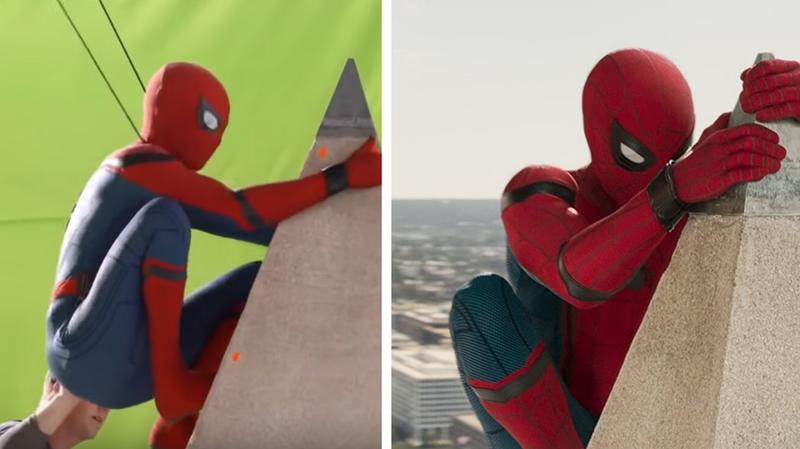
In order to requite the picture a different feel from the webslinger's previous forays, executive producer Victoria Alonso thought nearly doing away with Sony Pictures' ImageWorks, but afterward being impressed by their work, she enlisted the studio — alongside a dozen other VFX vendors. With more than than ii,000 VFX shots in the picture, Alonso insisted that "collaboration was key" — and she was right.
The Wolves in the Twilight Saga
Whether you're "Team Edward" or "Team Jacob," you can definitely concur that this behind-the-scenes shot from the Twilight films is… uncomfortable. Bella Swan (Kristen Stewart) pats Jacob Blackness (Taylor Lautner) on the caput — because that'southward way more than comfortable than patting a stand up-in domestic dog or a maquette, right?

For all of his wolf scenes, Lautner — whose grapheme shifts from homo to canine form — donned a gray morph suit and acted out every wolf-like movement. In the historic period of mo-cap professionals, this is sort of surprising. Maybe Lautner is just really method to the core?
Mustafar Lightsaber Duel in Star Wars: Episode III – Revenge of the Sith — Before
The Star Wars prequel films inkling fans into a lot of of import information, but, higher up all else, they center on Jedi Anakin Skywalker's (Hayden Christensen) descent to the dark side. Episode III promised to transform the young Jedi Knight into the legendary Darth Vader, which was no pocket-sized feat.

Fans were waiting expectantly to see how Anakin would betray those closest to him — besides as the Jedi Order and longtime mentor and pal Obi-Wan Kenobi (Ewan McGregor). In true Star Wars fashion, Anakin's journey ended in a legendary lightsaber fight to the death — sort of.
Mustafar Lightsaber Duel in Star Wars: Episode III – Revenge of the Sith — After
To gear up for the nearly eight-minute long sequence, McGregor and Christensen trained relentlessly to go the choreography down pat. Fighting with wooden dowels, the duo climbed around on wooden blocks and jumped from greenish object to light-green object.

In the concluding motion-picture show, the duo fights on the lava-filled planet Mustafar, venturing from a landing pad to a control eye and then out onto the factory ramparts, which teeter over streams of molten lava and burn. This makes the fight sequence — and the actors' portrayal — all the more impressive when you realize it was basically the two of them batting at each other with sticks in a green room.
Josh Brolin's Thanos in Avengers: Endgame
In the Marvel Cinematic Universe, the ultimate "big bad" of the long-running drove of films ends up being Thanos (Josh Brolin), a destroyer of universes. Thanos searches the milky way for the Infinity Stones, hoping to utilize their ability to magically snap away one-half of the universe's population.

While nosotros expected Brolin (or a body double) to clothing a pretty extensive motion capture accommodate to capture the hulking titan's mannerisms, nosotros didn't wait him to wear a cardboard cut-out of Thanos' caput high to a higher place his ain. The reason for the strange choice? It was a clever way to make certain the actors were looking at Thanos' confront in the terminal cutting.
Cyborg in Justice League
Of all the heroes in DC Comics' long-awaited Justice League, Cyborg (Ray Fisher) may be the least known of the crime-fighting characters. Although he does appear every bit a fellow member of the Justice League at times, Cyborg has more oftentimes been associated with the League's young developed counterparts, the Teen Titans.
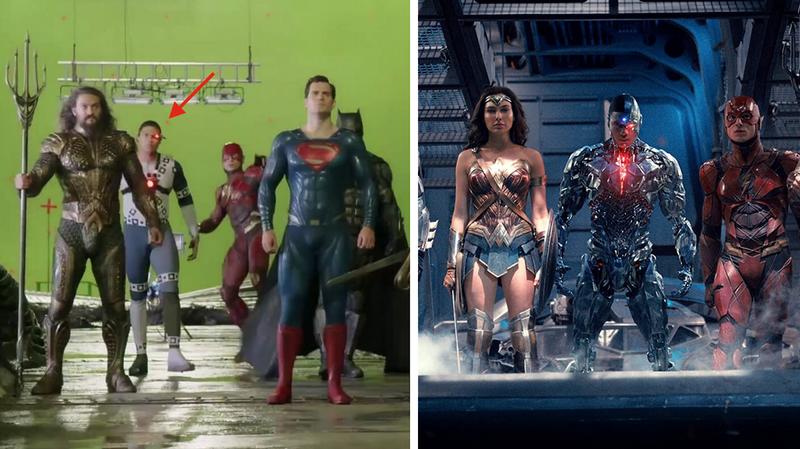
While most of the other heroes in the Justice League lineup got to don Amazonian armor, gauntlets from Atlantis and absurd, loftier-tech suits, Fisher put on a not bad motion capture accommodate, complete with lights and colour-coded sections to make it easier for artists to animate all of Cyborg's moving parts.
Beast from Beauty & the Fauna
Tale as quondam as time, right? Well, perchance not. While other versions of this story rely heavily on practical makeup effects — or the pencils of talented Disney animators — the 2017 remake, which stars Emma Watson and Dan Stevens every bit the titular duo, leans into motion capture.

On the left, Stevens dons a rather bulky motion capture suit, which leaves just his face exposed. The end outcome? A Beast who is nearly all figurer-generated — save his eyes, which are the existent thing. Allegedly, Disney felt this would requite the grapheme that "human element," just we can't aid but feel his performance was a tad stiff.
Portals in Medico Strange
Compared to Captain America or Fe Man, Medico Foreign is certainly one of Curiosity's less mainstream characters, but the character'south mystical time-infinite-bending powers allow for some pretty great — and rather complex — visuals.

Nominated for a All-time Visual Effects Oscar, Medico Foreign was described by cinematographer Ben Davis as "Marvel's Fantasia," thanks to its psychedelic, M.C.-Escher-inspired imagery. Director Scott Derrickson echoed these thoughts, saying that the mirror dimension chase was an attempt to take Inception "to the Nth degree… [make it] way more surreal." Thanks to green screens and some absurd lighting effects, the flick accomplished that vision.
Quidditch in the Harry Potter Series — Before
From the male child wizard slaying a basilisk to the chief trio being attacked by giant, enchanted chess pieces, at that place'southward a lot of awesome technical (witchcraft and) wizardry to point to in the Harry Potter series. But who didn't want to hop on a Firebolt broomstick and endeavour their hand at Quidditch?

Well, Radcliffe was glad to hang up his broomstick when the time came. Co-ordinate to the young actor, the rigs were uncomfortable, and shooting scenes for matches took quite a lot of time, meaning he spent a lot of fourth dimension dealing with discomfort on the annoying rig.
Quidditch in the Harry Potter Series — After
When shooting a Quidditch match, the crew filmed each actor separately and from multiple angles. Later, all that footage had to be pieced together to grade a fluid game. Most actors used the mechanical rigs Radcliffe wasn't fond of, but it meant filmmakers could control (or "steer") the "broom" for the shots.

Add in some artificial wind and the green (or blue) screen magic and presto — flying broomsticks. According to a behind-the-scenes featurette, a few other Quidditch scenes were shot using trampolines, which Ron Weasley actor Rupert Grint said was "quite scary."
Fight Sequences in The Matrix — Before
Written and directed past the Wachowskis, 1999's cyberpunk action film The Matrix took the globe past storm. (Kind of literally?) The sci-fi masterpiece depicts a dystopian future in which humanity is unknowingly trapped inside a simulation of reality — a.k.a. the titular Matrix.
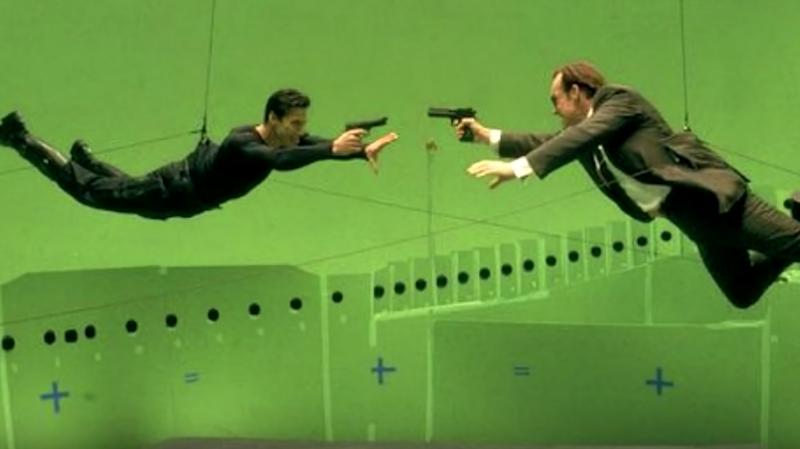
The simulation has been created by machines to distract humans from the fact that their bodies are being used as an energy source. When Neo (Keanu Reeves) discovers the truth, he is pulled into a rebellion — 1 he might have to pb. In creating this fashionable pic, the Wachowski'due south leaned heavily into the aesthetics of Japanese anime and martial arts films.
Fight Sequences in The Matrix — Later on
In leaning into these visuals, the writer/director duo besides capitalized on the use of fight choreographers and the "wire fu" techniques that were popularized by Hong Kong activity cinema. In addition to using rigs and wires to create gravity-defying fights, The Matrix is too known for popularizing "bullet fourth dimension."

In "bullet fourth dimension," a character'south heightened perception is represented by the action inside a shot moving in deadening-motion while the camera moves at normal speed. Needless to say, this fun outcome — and some CGI — allow for Neo to dodge bullets, and it paved the way for an on-screen depiction of Spider-Human being's "Spidey sense."
Quicksilver's Speedy Antics in X-Men: Days of Hereafter Past
In X-Men: Days of Future By, super-speedster Quicksilver (Evan Peters) puts his powers on total brandish during one of the picture's about memorable scenes, where he dashes effectually the Pentagon kitchen to reposition and disarm the guards pursuing him and his cohort.

Everything around Quicksilver moves in seeming tiresome-motion to emulate his point of view, so before Wolverine (Hugh Jackman) can even fully extend his claws, the speedster already makes quick work of the enemies. For the sequence, Peters was filmed running in place, allowing him to act out all of Quicksilver'due south antics to a "T." Afterwards, the VFX team added in loads of CGI props, from bullets to frying pans, all of which had to be choreographed perfectly.
All Those Fight Sequences in 300: Rise of an Empire
"This. Is. Sparta!" And by "Sparta," we hateful the state of greenish screens. In 300: Ascent of an Empire, the picture keeps the stylistic flair of its predecessor — equally well equally what can best be described as a filter those who are new to Instagram run all their posts through.

Jokes aside, Rise of an Empire is a visual treat. This battle on a send takes place in a green room where prop masters congenital only the transport'due south flooring. You'll notice the light-green "X'south" on the ground, which helped actors striking their marks, and VFX artists removed that pesky tape in post-production.
THAT Final Boxing in Avengers: Endgame — Before
A 21 motion picture lead-up meant that the anticipation for Avengers: Endgame was high — dangerously loftier. We all knew it would stop in a climactic battle, but, somehow, the folks behind the Curiosity Cinematic Universe exceeded our wildest expectations.

Throngs of recognizable characters from the final decade of films filled the screen in the final face up-off against Thanos (Josh Brolin). Getting all the characters together took a lot of wizardry — both in terms of the film's bodily plot and in terms of the actual VFX processes backside the scenes.
THAT Terminal Boxing in Avengers: Endgame — After
One of the almost exciting shots shows Tessa Thompson'southward Valkyrie, a grapheme introduced in Thor: Ragnarok, on her trusty winged steed. In reality, that horse was just a saddle-similar structure that allowed for a scrap of movement, supported past some folks dressed in greenish suits.
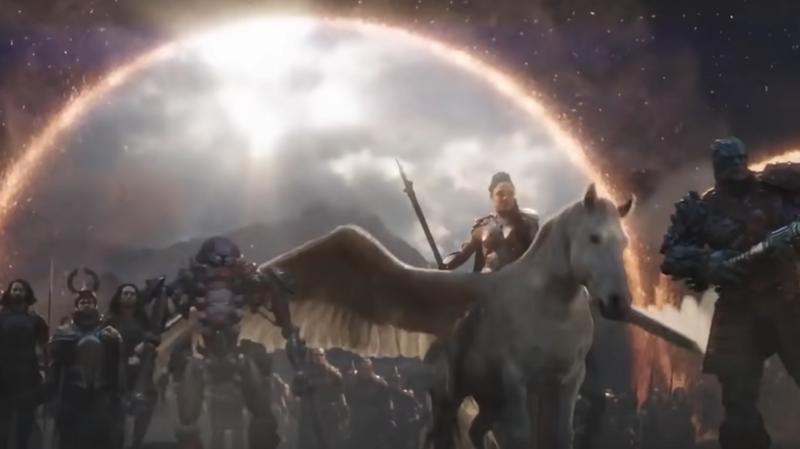
Other characters as well as the Doctor Foreign portal effect and the sunday-punctured sky backside Valkyrie and her cohorts were all added, cheers to the help of a trusty green screen. In fact, all of the Avengers assembled in a giant light-green room and just executed a lot of absurd fight choreography. The VFX squad transformed that gaping room into a battlefield for the ages.
Luke Skywalker's Robotic Hand in Star Wars: Episode VIII – The Terminal Jedi
In Star Wars: Episode V – The Empire Strikes Back, Luke Skywalker loses his manus during a lightsaber duel with Darth Vader. In that same iconic scene, the Sith Lord also reveals that he's Luke's father. In many ways, Luke'south on-screen portrayal changed from that point forward.

Although he's fitted with a robotic hand and a peel-graft in the original films, Luke becomes less interested in hiding his metal phalanges in Episode 8. In club to capture the look and move of the paw just right, VFX artists fitted Marker Hamill's joints with these crafty greenish bands.
Function King of beasts in The Wolf of Wall Street
Martin Scorsese'due south 2013 dark comedy crime film The Wolf of Wall Street is based on Jordan Belfort's memoir of the same name. In it, Belfort recounts his career as a New York Urban center stockbroker and the ways in which his firm, Stratton Oakmont, engaged in debauchery, abuse and fraud.

The Oscar-nominated pic became Scorsese'due south highest-grossing flick, but information technology wasn't without controversy. Unlike Life of Pi's tiger, the panthera leo that padded effectually the depraved role was the real bargain, which drew complaints. While shooting, a handler walked the leashed lion around an empty office. Later, the handler was edited out, and the office employees were added in.
The (Motion picture-Long) Auto Hunt in Mad Max: Fury Road
Technically, Mad Max: Fury Road is kind of the anti-green screen picture. Director George Miller has stated that 90% of the furnishings in his postal service-apocalyptic masterpiece are applied. With droves of modified hot rods, loads of camera rigs and more than 150 stunt performers, Fury Road was filmed on location in Commonwealth of australia.

"As far as I know, the only VFX on our costumes was the green glove [Charlize Theron] wore to hide her arm," said costume designer Jenny Beavan. "And they also took out wires from the [stunt] harnesses." Due to the harsh filming conditions, VFX were mostly used to modify the time of day, terrain and weather condition furnishings.
Jar Jar Binks in Star Wars: Episode I – The Phantom Menace
Clumsy but well-intentioned, Jar Jar Binks tried to bring some levity to the prequel films, but for many viewers, he wasn't lovable at all. However, bringing the Gungan to life — CGI tongue and all — was a existent feat for the ILM VFX team.
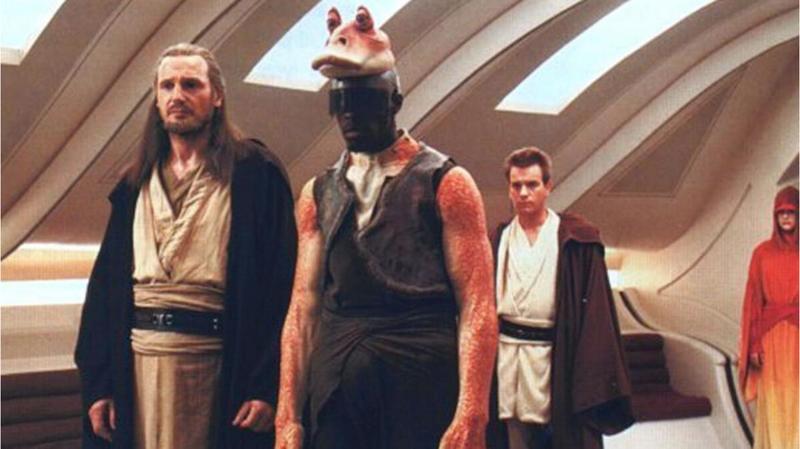
Ahmed Best, who provided Jar Jar'south vocalism and motion capture functioning, had a fun time filming Episode I, even with the Jar Jar maquette on his caput. Although fans' unwarranted dislike led to some dark times in Best'southward life, he could take solace in the fact that at least his face wasn't associated with the much-hated character.
The Android in Ex Machina
Like Mad Max: Fury Road, Ex Machina defines our typical VFX expectations. In this psychological sci-fi thriller from writer/director Alex Garland, a programmer (Domhnall Gleeson) is invited by his CEO (Oscar Isaac) to administer the Turing test to an intelligent robot (Alicia Vikander) to decide her level of humanity.

Fabricated with a budget of merely $xv million, Ex Machina ended up winning the Oscar for All-time Visual Effects. Impressively, during filming, the crew didn't use any green screen or tracking markers. Instead, scenes were filmed both with and without Vikander, allowing post-production teams to digitally pigment out the parts of her that the android body wouldn't need.
Carol Danvers' Flight in Captain Curiosity and Avengers: Endgame
In 2019, Helm Marvel became the first female-led superhero film to pass the billion-dollar marker. Although Brie Larson'southward Captain Marvel (a.yard.a. Carol Danvers) doesn't require the makeup that other non-human being characters require, she still gets her fair share of VFX support.

For ane thing, the flight sequences are all done against dark-green screens, with Larson hooked up to various rigs and wires that allow her to perform acrobatic stunts — or be "puppeteered" by the trusty stunt team. In some sequences, Larson's hair is even digitally added in to give it all those floaty, glowing furnishings.
Wonderland and Its Inhabitants in Tim Burton's Alice in Wonderland
Tim Burton'south 2010 Alice in Wonderland kicked off quite a few trends. First, it helped usher in the age of darker, gritty reboots. 2nd, information technology kick-started a trend of live-action fantasy films being greenlit by Disney. Third, it cemented Burton's commitment to making entire fantasy worlds using CGI and green screen effects.

While sure elements of the fix were created by designers, almost characters and backdrops were dreamed up entirely in postal service-production. Instead, filmmakers crafted some pretty inventive green screen and mo-cap suits, including the thin-legged, bulbous suits seen here, which were used for Tweedle Dee and Tweedle Dum.
All Those Gritty Fight Sequences in Superman v Batman: Dawn of Justice
It'due south a bird. Information technology'south a plane. Information technology's — a lot of green screens. Superman has been around for quite some fourth dimension, and back in the day, those Christopher Reeve films featured some pretty obvious composite backgrounds — a.yard.a. flying Kal-El and Lois Lane were essentially pasted over background footage.

Now, much like Captain Marvel, Superman'southward ability of flight happens courtesy of some inventive rigs and cables and CGI backgrounds. In Superman 5 Batman: Dawn of Justice, fans tin can catch a whole lot of flying fun and some great fight scenes, most of which were shot confronting green screen backgrounds earlier being transformed into gritty, dark setpieces.
Kylo Ren and Luke Skywalker's Duel in Star Wars: Episode Eight – The Last Jedi
Rian Johnson'south entry in the Star Wars sequel trilogy brought some of the saga's near thrilling setpieces to life. From Admiral Holdo'southward (Laura Dern) sacrificial starship maneuver to Rey (Daisy Ridley) and Kylo Ren'due south (Adam Driver) lightsaber battle squad-up, The Last Jedi is full of flair.

When Kylo Ren faces off against his uncle and former Jedi Main, Luke Skywalker (Mark Hamill), on the red table salt planet of Crait, the snow-like salt is a applied effect — while the residuum of the planet is rendered in postal service. Different the Star Wars prequels, which saw actors using wooden dowels equally sabers, the sequel trilogies upgraded things a bit.
Source: https://www.ask.com/entertainment/hollywood-blockbuster-moments-green-screens?utm_content=params%3Ao%3D740004%26ad%3DdirN%26qo%3DserpIndex
0 Response to "Shit Here We Go Again Green Screen"
Post a Comment